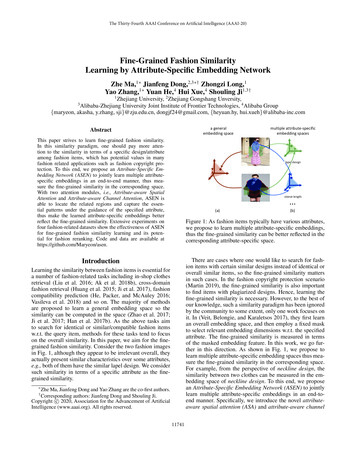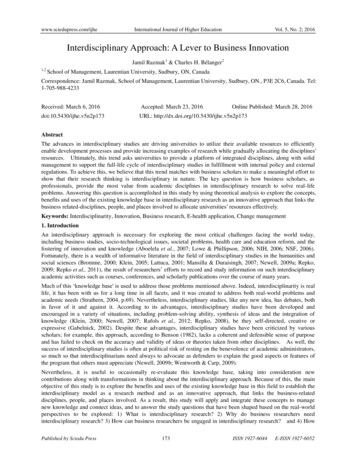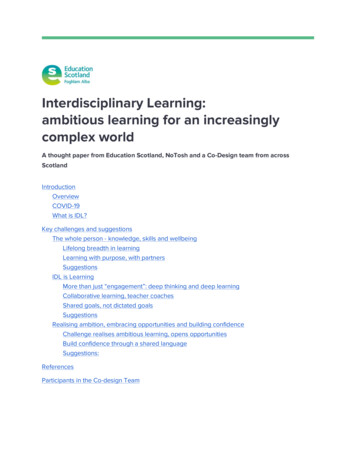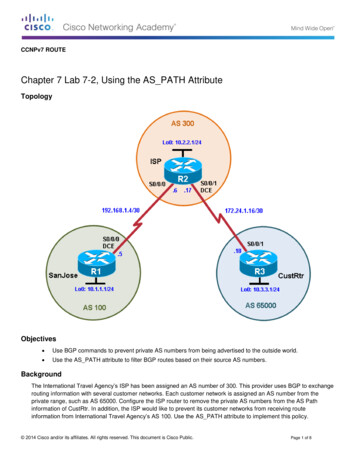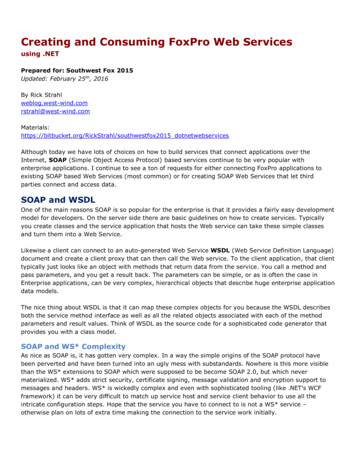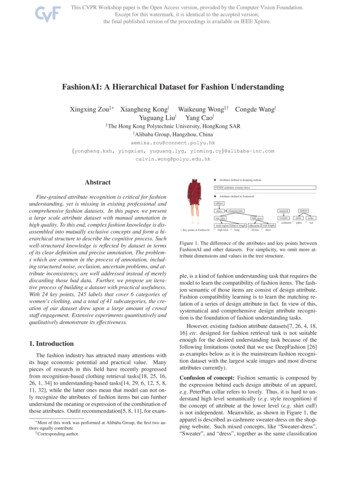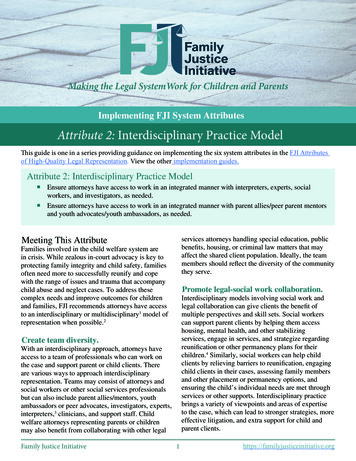
Transcription
Making the Legal SystemWork for Children and ParentsImplementing FJI System AttributesAttribute 2: Interdisciplinary Practice ModelThis guide is one in a series providing guidance on implementing the six system attributes in the FJI Attributesof High-Quality Legal Representation. View the other implementation guides.Attribute 2: Interdisciplinary Practice Model Ensure attorneys have access to work in an integrated manner with interpreters, experts, socialworkers, and investigators, as needed. Ensure attorneys have access to work in an integrated manner with parent allies/peer parent mentorsand youth advocates/youth ambassadors, as needed.Meeting This Attributeservices attorneys handling special education, publicbenefits, housing, or criminal law matters that mayaffect the shared client population. Ideally, the teammembers should reflect the diversity of the communitythey serve.Families involved in the child welfare system arein crisis. While zealous in-court advocacy is key toprotecting family integrity and child safety, familiesoften need more to successfully reunify and copewith the range of issues and trauma that accompanychild abuse and neglect cases. To address thesecomplex needs and improve outcomes for childrenand families, FJI recommends attorneys have accessto an interdisciplinary or multidisciplinary1 model ofrepresentation when possible.2Promote legal-social work collaboration.Interdisciplinary models involving social work andlegal collaboration can give clients the benefit ofmultiple perspectives and skill sets. Social workerscan support parent clients by helping them accesshousing, mental health, and other stabilizingservices, engage in services, and strategize regardingreunification or other permanency plans for theirchildren.4 Similarly, social workers can help childclients by relieving barriers to reunification, engagingchild clients in their cases, assessing family membersand other placement or permanency options, andensuring the child’s individual needs are met throughservices or other supports. Interdisciplinary practicebrings a variety of viewpoints and areas of expertiseto the case, which can lead to stronger strategies, moreeffective litigation, and extra support for child andparent clients.Create team diversity.With an interdisciplinary approach, attorneys haveaccess to a team of professionals who can work onthe case and support parent or child clients. Thereare various ways to approach interdisciplinaryrepresentation. Teams may consist of attorneys andsocial workers or other social services professionalsbut can also include parent allies/mentors, youthambassadors or peer advocates, investigators, experts,interpreters,3 clinicians, and support staff. Childwelfare attorneys representing parents or childrenmay also benefit from collaborating with other legalFamily Justice Initiative1https://familyjusticeinitiative.org
One of the earliest examples of interdisciplinaryparent representation is the NYU Family DefenseClinic.5 After the professors teaching the cliniclearned how much out-of-court work was necessaryto successfully advocate for parents, the clinicbegan partnering with social work students to createinterdisciplinary teams for each case.6 A previousclinic faculty member shared that after social workersjoined the team, “we were able to serve our clientsmore fully as individuals. As lawyers and socialworkers working together, we were able to betterunderstand each family’s unique strengths and needsas well as consider both legal and nonlegal strategiesfor advancing our clients’ goals.”7 With social workersas partners, the clinic could better participate inagency conferences, assess agency service plans, andcreate alternative plans based on each family’s specificneeds to give the families the best chance for safe andsuccessful reunification.8 This example also highlightshow partnering with local university social workprograms can achieve an interdisciplinary approachwhen resources are limited.Mandated reporting. The potential clash betweena social worker’s status as a mandated reporter ofchild abuse and neglect and an attorney’s duty ofclient confidentiality may pose one such challenge.12To maintain full client confidentiality and fulfill theprimary goal of high-quality legal representation forparents and children, social workers collaborating withparent or child attorneys should be relieved of theirmandatory reporting duty. In the District of Columbia,for example, social workers are not mandatoryreporters when they are performing social workservices exclusively for a lawyer or law firm engagedin legal representation.13 In Louisiana, a socialworker who is “engaged by an attorney to assist inthe rendition of professional legal services” to a childin a dependency case is exempt from the mandatoryreporting requirement.14 Clear statutory exemptionssuch as these are ideal to support collaboration whenproviding legal services.Unfortunately, in many states, the interplay betweenmandatory reporting requirements and legal ethicsrules creates ambiguity for social workers employedby legal organizations. In determining how toimplement high-quality interdisciplinary practicemodels, jurisdictions should consult state and localstatutes regarding mandatory reporting, attorneyrules of professional conduct, and social worklicensure standards and ethical obligations. Someinterdisciplinary clinics and law offices contendthat social workers in interdisciplinary practices arepart of the legal team and thus subject to the sameclient confidentiality requirements as attorneys.15Others have instituted policies that require advisingeach client of mandated reporting requirementsof team members or possibly avoiding use ofmandated reporters in cases where a conflict may beapparent. However, despite the potential for conflict,interdisciplinary practices report confidentialityissues are infrequent and usually resolved in a wayacceptable to all team members.16 A key to resolvingthis issue when it does arise is having client-centeredpolicies and procedures in place to assess perceivedrisk and deciding as a team how to best advise theclient given the circumstances.17Know the benefits of interdisciplinaryrepresentation.A growing body of evidence supports the efficacyof interdisciplinary models of parent and childrepresentation. For example, a multi-year studypublished in 2019 examined the outcomes of 9,582families involved with the child welfare system inNew York City. It found that children of parentswho were represented by an interdisciplinary lawoffice spent almost four months less in foster careand achieved permanency, including reunification,and guardianship faster than children of parents whoreceived solo attorney representation.9 Other studieshave also found a positive impact for interdisciplinaryteams representing children. A Flint, Michigan studyfound interdisciplinary teams support case resolutionand family preservation through a greater likelihood ofcase dismissal at adjudication, an increased likelihoodof placement with relatives instead of foster care, anda decrease in termination of parental rights petitions.10Devise a plan for resolving conflicts.Because interdisciplinary models of representationrequire collaboration between colleagues withdifferent training, perspectives, and ethical orlicensure obligations,11 challenges and conflicts cansometimes arise.Family Justice InitiativeSocial worker testimony. Additionally, jurisdictionsseeking to create interdisciplinary legal practicesshould consider whether and how social workerswill testify on behalf of their clients or be subjectto subpoenas to testify issued by opposing counsel.2https://familyjusticeinitiative.org
Issues of privilege and ethical obligations mayaffect these proceedings; jurisdictions shouldconsult relevant authorities, including state statutes,professional regulations, ethics opinions, and case lawwhen needed.Technical AssistanceFJI team members are available to helpimplement the FJI attributes.Visit the Family Justice Initiative websitefor more information.Examples of Good PracticeThe following examples represent interdisciplinarypractice models that have pioneered the approach forrepresenting children and families in child welfarecases. Many other successful models exist.The Peer Advocates and TAY specialists, MHAT andCARE teams are available to consult on specific issuesor general case planning and strategy for any child ornon-minor dependent represented by CLC, regardlessof which firm or unit has primary case assignment andresponsibility.Interdisciplinary Child Representation ModelsChildren’s Law Center of California (CLC)CLC is a nonprofit, public interest law firm thatrepresents children involved with dependency courtdue to abuse, neglect, or abandonment. CLC findsthat a holistic, interdisciplinary approach to advocacyis essential to serving this high-risk, high-needspopulation.Interagency collaboration. In addition to social workinvestigator support and the specialty unit teams,CLC’s interdisciplinary approach involves a high levelof collaboration between its law firms and other legalorganizations and nonprofits in California specializingin areas such as education, benefits, mental health,and adoption. This collaboration helps ensure clients’specific issues are being addressed. CLC findsinteragency, interdisciplinary collaboration is evenmore important in smaller counties where resourcesand staff are limited.Social work investigator support. CLC has five lawfirms in Southern California and two in NorthernCalifornia, including one firm that functions asa specialty unit. Each firm employs social workinvestigators to assist attorneys on cases, with oneinvestigator for every two attorneys. Investigatorsassist with work outside of court, such as visiting thechild in the home or attending transition meetings.Consistent communication. The key to the model’ssuccess is strong and consistent communication toensure all the players have the most comprehensive,current information about the child and family andhave reached consensus about case strategy and thefamilies’ service needs. In addition to internal teammeetings, the CSEC specialty team also holds weeklyinterdisciplinary team meetings with other systempartners including child welfare, county counsel,probation and service providers to share informationand resolve disagreements on cases on the calendarfor the following week. CLC finds it is critical tobe upfront with clients when an advocate or partneragency is a mandated reporter.Specialty unit teams. In the specialty unit,interdisciplinary teams of specialists work on cases fordual status youth, mental health advocacy, commercialsexual exploitation of children (CSEC), specialeducation advocacy, and non-minor dependents inextended foster care. For example: the Mental Health Advocacy Team (MHAT)consists of a clinician and an attorney with astrong mental health background; the Cross-over Advocacy Resource Effort(CARE) features social workers, attorneysupervisors, case managers, and internsfrom local universities’ social workprograms; Peer Advocates and Transition Age Youth(TAY) specialists are younger staff who haveexperienced foster care and excel at connectingwith hard-to-reach youth.Family Justice InitiativeChildren’s Law Center, Washington, DC(CLC)CLC uses an interdisciplinary approach that bringstogether attorneys, investigators, social workers,and special education attorneys to support its childcentered advocacy on behalf of children in abuse andneglect cases.3https://familyjusticeinitiative.org
Team members. Every case has an assignedinvestigator who assists with client visits, backgroundresearch, records requests, subpoenas, and otherinvestigative and case assistant tasks. Social workersand special education attorneys are included oncase teams as needed. Through regular and closesupervision, attorneys identify opportunities toinclude other team members and work to spot issuesfor collaboration. Supervisor feedback on teaming,delegation, and use of investigators, special educationattorneys and social workers is important to thesuccess of this model.an attorney and a Child Advocacy Specialist.18Child Advocacy Specialists are social servicesprofessionals with a variety of expertise in areas suchas social work, mental health, education, or childdevelopment.19 The wide diversity in the teams’knowledge and experience is critical because childabuse and neglect cases typically have more than oneissue that needs to be addressed. This also is importantbecause KidsVoice represents clients until they turn25, which means the teams help with school issues,housing, social security, criminal summary offenses,expungement, and much more.Social worker roles. Each new case receivesa check-in from a social worker who providesrecommendations to the attorney. For cases involvingcomplex clinical issues that could benefit fromthe ongoing involvement of a social worker, theattorney can refer the case for social work briefadvice, social work consultation (ongoing advice andsome case tasks, though often behind-the-scenes),or social work collaboration (the full integration ofthe CLC social worker into the representation). Thesocial workers add value to the team in a variety ofways, but a few include identifying inappropriateservices in boilerplate plans and completingbiopsychosocial assessments of potential caregivers.CLC social workers are also helpful in litigation, asa countervailing clinical perspective to that of theagency can sometimes “level the playing field” incases where the child’s attorney and agency are inopposition.Valuing different viewpoints. KidsVoice finds thatvaluing different points of view, especially aboutwhat should happen in a case, is what makes the teammodel both powerfully effective and challenging. Partof the challenge is that social services professionalsare trained to help clients move forward at their ownpace, while attorneys need to make recommendationsand provide evidence on the court’s timeline. Thiscreates an inherent but valuable tension that leadsto recommendations and services tailored to eachclient’s unique needs. KidsVoice has not faced ethicalissues with mandated reporting in its 19 years ofinterdisciplinary practice. It believes that with properpolicies, those issues can be successfully addressedwhile honoring the professional ethics of everyoneinvolved.Managing success. Supervision and management arekey to ensuring the interdisciplinary team model runssmoothly. KidsVoice provides initial and ongoingtraining, encourages strong communication betweenteam members, and facilitates accountability throughmonthly supervisory meetings, quarterly file reviews,performance incentives, and year-end performancereviews.20 KidsVoice emphasizes providing plentyof feedback and setting clear expectations but alsotrusting staff to handle these challenging cases.Special education attorney roles. Special educationattorneys are also an important part of theinterdisciplinary team. Like social workers, assignedspecial education attorneys may provide brief advice,consultation, or ongoing work (including directrepresentation of the child’s education decision makerwhere appropriate). Addressing educational issues isimportant for both the permanency and wellbeing ofCLC’s child clients.Legal Aid Society’s Juvenile Rights Practice,New York (JRP)JRP provides comprehensive legal representationto children involved in child welfare, juveniledelinquency, and Persons in Need of Supervisionmatters. JRP believes children are best served by aninterdisciplinary practice model that ensures eachchild is receiving appropriate services in addition tozealous advocacy.KidsVoice, PennsylvaniaKidsVoice is a nonprofit agency that providesinterdisciplinary advocacy for children involved in thechild welfare system in Allegheny County’s JuvenileCourt.Team members. Each child client is represented bya team that includes at least two co-equal partners:Family Justice Initiative4https://familyjusticeinitiative.org
Intake team. JRP’s interdisciplinary approach beginswith an intake team that includes attorneys, socialworkers, paralegals, and administrative data staffand supervisors. At intake, the social worker gathersinformation, speaks with caseworkers, and works withthe attorneys to assess the case. After arraignmentand assessment, the intake team meets informally todetermine which cases require a social worker for thelong term.supported by staff attorneys who provide ongoingcase consultation, technical assistance, and occasionalcourt coverage. This interdisciplinary collaborationassures the child receives comprehensive, zealousadvocacy, using all resources available through thecourt systems and public services. In addition to directlegal advocacy, the lawyer-social worker teams offerpositive, consistent, and trusting relationships that areessential to help a client heal.Social worker roles. Social workers play a vital rolein cases by interfacing with agency social workers,advocating for clients, and keeping attorneys abreastof client needs. Because of the value social workersbring to teams, ideally a social worker would be a partof each team throughout the life of every case, but dueto budgetary constraints, they only work on the moreintensive cases past arraignment.Case handling. Caseload caps are an essentialinstrument of quality control. The typical volunteerattorney represents one child or a sibling group. A fulltime child advocate social worker serves 50 children.Twenty child advocate social workers and 10 staffattorneys work with more than 340 volunteer attorneyseach year to represent 1,100 children and youth. Ina nationally recognized initiative, the Support Centeris also working with Child Advocacy Practice Groupsin 26 major Philadelphia law firms and corporatelegal departments, as a source of collegial support andadditional training for volunteers.Addressing challenges. Some challenges JRPencounters with interdisciplinary practice include: conflicting viewpoints by team members oncases -- JRP attorneys share that conversationis key to overcoming this challenge andteams take the time to discuss their differentexperiences and opinions and form a unifiedposition to present. high caseloads of the social workers cancreate challenges because a social workermay have many cases all requiring the highestpriority. confidentiality is not a challenge because,under JRP policy, social workers are partof the legal team so they are covered byattorney-client privilege. Rather than createconfidentiality conflicts, social workers arekey to assessing risks of harm to clients andhelping create safety plans.“Whole child” representation. The Support Centerprovides “whole child” representation, addressingissues of safety, permanency, and well-being, soclients can recover, heal, and succeed. The SupportCenter advocates for a child’s collateral issuesand services, including education and health care.Team members work closely and collaboratively,conducting most activities together including homevisits, collecting information from service providersand caregivers, attending interdisciplinary service planmeetings and court appearances to best represent andadvocate for clients’ needs.Interdisciplinary Parent Representation ModelsWashington State Office of Public Defense,Parents Representation Program (PRP)The Washington State Office of Public Defensecontracts with attorneys to represent indigent parentsin child welfare proceedings as part of its ParentsRepresentation Program (PRP).Support Center for Child Advocates, Pennsylvania(Support Center)The Support Center is the nation’s oldest and largestvolunteer lawyer program dedicated exclusively torepresenting children who have experienced abuse andneglect.Partnering with independent social workers. Theprogram approaches interdisciplinary practice bycontracting with independent social workers that canbe part of the family defense team at the attorney’sdiscretion. There is currently about one full-timesocial worker for every three full-time attorneys in theprogram. Additionally, some individuals with socialTeam approach. Since its founding in 1977, theprogram has teamed volunteer attorneys with masterslevel staff child advocate social workers to representindividual children and sibling groups. The teams areFamily Justice Initiative5https://familyjusticeinitiative.org
worker contracts with the PRP are parents who wereformerly involved in the child welfare system and canbring that perspective to the defense team’s support ofa parent client.strong emotional intelligence. Parents for Parents ProgramsThe Washington State Office of Public Defensealso funds an outside agency to manage, train,and coordinate county-level Parents for Parentsprograms. This program connects parents whohave successfully navigated the child welfaresystem (“parent allies”) to parents who haverecently become involved in a child welfarecase. While not part of the defense team, thisprogram often works with the defense team andsupports parents experiencing the child welfaresystem.Social workers act as “language” translators,advocates, and supports for parents in the complexlegal process and are essential to addressing certainaspects of cases that attorneys lack the special skillsand knowledge to resolve. PRP finds that whenattorneys and social workers communicate well andwork separately but cooperatively on the legal andnonlegal issues that stand in the way of reunificationor permanency, the interdisciplinary approachfunctions well.New Mexico Family Advocacy Program(NMFAP)Confidentiality. Under the Washington Courts Rulesof Professional Conduct, the program social workersare considered nonlawyer assistants, or agents of theattorneys. Thus, social workers must balance theirconfidentiality duties with their mandated reporterstatus under Washington State law. However, PRPfinds that mandated reporting is rarely an issue.Typically, if abuse did occur, it was before the initialremoval and if the parent is not doing well, the childis not in the parent’s care. Further, the parent willtypically be counseled to not request return of a childif the parent is not ready because of safety concernsand risk that if the child is removed again, the agencyis likely to attempt to quickly terminate parental rights.NMFAP provides representation to parents in childwelfare cases using an interdisciplinary team oflawyers, social workers, and parent mentors. Theprogram began as a pilot project in one judicial districtin 2013 after a visit to observe the Center for FamilyRepresentation (CFR) interdisciplinary model in NewYork. Initially, the social workers and parent mentorswere funded in a piecemeal way using AdministrativeOffice of the Courts (AOC) general funds and someCourt Improvement Program funding. After applyingfor a federal grant targeted for child welfare agencies,NMFAP was awarded a 7.7 million grant in 2018 tofully staff the existing program and expand into twomore judicial districts.Independent experts. PRP also provides funding forand encourages using independent experts to supportthe parent defense team. Experts are used to providefirst or second opinion evaluations; home studies ofparent clients, relatives or fictive kin; depositions;opinions in complex medical cases; and social workerforensic reviews to evaluate the state child welfareagency’s compliance with state policy or practice.Social worker/parent mentor roles. Social workersplay an important role on the team by helpingparents engage in the child welfare legal processand services. Social workers provide clinical casemanagement, attend agency meetings with parents,advocate for parents, help with concurrent planning,and recommend resources and supports to parents.At NMFAP, social workers are considered a part ofthe legal team, so they cannot be called to testify.Despite being on legal teams, the social workersare still mandated reporters and make sure tocommunicate this to the parent clients immediately.Social workers have had to report a few times in thesix years NMFAP has worked with parents but nomajor problems have occurred. In addition, NMFAPhas recently hired a group of parent mentors and iscurrently integrating them into their interdisciplinaryteam practice.Team approach benefits. PRP emphasizes, whenimplementing an interdisciplinary approach,communicating to attorneys that their representationis by no means deficient but that parents in these casesare better supported by a team of allies. In fact, whenPRP provides technical assistance on stuck cases,often using a social worker or expert is identified as anavenue to help resolve the case. PRP also emphasizesgood hiring practices, particularly focusing oncontracting with social workers and attorneys who areskilled and passionate about social justice and haveFamily Justice Initiative6https://familyjusticeinitiative.org
Expanding the interdisciplinary approach. NMFAPand its interdisciplinary approach is an important stepforward in improving legal representation for parentsin certain judicial districts of New Mexico. A taskforce created by the legislature is currently meeting torecommend best practices and potential structures tobest support families and attorneys in the child welfaresystem across the state. This work has the potentialto expand the interdisciplinary representation modelthroughout New Mexico.Addressing challenges. When Bronx Defendersfirst began FDP, a challenge was getting the childwelfare agency to accept and collaborate with theirrepresentation team, which took time, perseverance,and relationship building. Another challenge wasobtaining funding because many jurisdictions did notfully understand the benefits of an interdisciplinaryparent representation model. In addition to protectingfamilies’ rights, FDP finds the model saves money,resources, and time because when more work withthe parents is completed between court dates, lesslitigation is needed.New York City Interdisciplinary ParentRepresentation Models21Brooklyn Defender Services, FamilyDefense Practice (BDS-FDP)Bronx Defenders, Family Defense Practice(FDP)BDS-FDP represents low-income parents in childwelfare cases in the Brooklyn Family Court. BDSFDP takes an interdisciplinary approach to protectclients’ right to family integrity by teaming attorneyswith social workers, paralegals, and administrativestaff. Combining different disciplines allows the teamto advance clients’ cases in court while providingclients benefits and services to keep familiestogether or help them safely reunify. BDS-FDP alsocollaborates with teams in BDS’s other legal practices,such as criminal, immigration, or housing, to theirclients benefit.FDP takes a holistic, interdisciplinary approach tofamily defense. Their holistic defense model is basedon the understanding that there is rarely only one thinggoing on with a client and there are usually multipleconsequences of a family’s interaction with the legalsystem. This requires an interdisciplinary responseto address each interlocking issue, including whatbrought the family to the attention of the child welfaresystem and what barriers exist to meeting case goals.Social worker collaboration. At FDP, social workersand parent advocates work alongside lawyers tosupport families in child protection proceedings.Advocates and social workers help gain parents’ trust,which encourages them to confide the actual issuesthat need to be addressed in the family. Advocatesand social workers also play an important role inadvocating for clients at agency conferences andmeetings, keeping attorneys updated on changes inthe case, and helping cases move forward. Finally,advocates and social workers go above and beyondthe reasonable efforts requirements that child welfareagency caseworkers must meet to ensure the parentshave a workable case plan and resources to fulfill thegoals.Center for Family Representation (CFR)CFR provides legal assistance and social workservices to families in crisis, with the goal ofpreventing children from entering foster care orminimizing time spent in foster care. CFR usesfamily defense teams, which include an attorney,social worker, and parent advocate. The team worksto improve outcomes for families through in-courtlitigation, out-of-court social work referrals andcase management, individualized service planning,and parent mentoring. The teams practice a sharedownership/authorship model of interdisciplinarypractice, which means every team member is equallyresponsible for decision making throughout the case.22Attorneys and social workers are trained together,share offices and files, and attend intake meetings.23Internal data collected by CFR indicates the modelis helping families stay together: in 2018, over 54percent of the children of CFR’s parent clients didnot enter foster care and the children who did hadsignificantly shorter foster care stays compared to cityand state medians.24Civil legal advocate collaboration. In addition toworking with social workers and advocates, FDPlawyers also collaborate with civil legal advocates,who can help parents apply for food stamps, housing,and other benefits, as well as other lawyers withexpertise in areas such as housing, criminal justice,and immigration to help serve their clients.Family Justice Initiative7https://familyjusticeinitiative.org
Neighborhood Defender Service of Harlem, FamilyDefense Practice (NDS)NDS represents parents from Northern Manhattan inabuse and neglect proceedings using a communitybased, interdisciplinary, client-centered model.then determines how best to meet the client’s needswith staff in the office. In practice this can look likethe family defense attorney working in family court,while an immigration attorney, defense attorney, orother attorney works on the client’s behalf on othercases.Team approach. NDS’s interdisciplinary approachinvolves a variety of professionals working to
Children's Law Center of California (CLC) CLC is a nonprofit, public interest law firm that represents children involved with dependency court due to abuse, neglect, or abandonment. CLC finds that a holistic, interdisciplinary approach to advocacy is essential to serving this high-risk, high-needs population. Social work investigator support.

